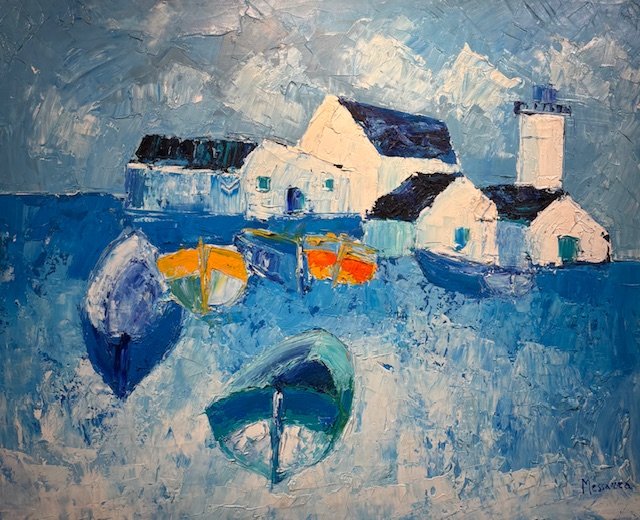An article by cn (591 Words, 3 Min. Read)
Robert Messarra’s Retrospective, at Kalim Bechara Gallery, Unfolds Like the Quiet Opening of a Diary Long Hidden from the World. Titled What Remainsand Currated with Deep Emotion by Randa Sadaka, The Exh force
Each Canvas in this Retrospective Feels Like a Page Torn from a Luminous Inner World: Landscapes, Interiors, Boats Adrift Not Just on Water, But Through Time and Solitde. Messarra, Who Left Lebanon During the CIVIL WAR, Never Stoped Painting it, Not As it was, but as it is Lived on in memory, filled Through longing and light.

Between Joy and Exile
There is the Something Deeply Paradoxical in Messenger’s work. Though marked by personal tragedy –he Lost Both Parents at a Young Age and Spent Decades in Exile -His Painments are Anything But Bitter. Instead, they Pulse with Joy, Color, and An ALMOST Childlike Wonder. The Mediterranean Runs Through them Like A Bloodstream: Its Grens, Its Sun-Soyeded Whits, Its Horizon Lines that Feel Like The Edge of Prayer. His France-Based Years in Carcassonne and Paris Never Darkened this Vision. On the Contrayy, Distance Seemed Only to Sharpen His Sense of Beauty.
A Landscape of Emotion and MATTER
In one unforgettable party from the show, trees rise from a snowly Valley Like Tall Figures Weatherd by Time. Their bark is sculpted in Bold Yellows and Greens, their Branches Stretching Against a Sky of Lilac and Storm-Blue. Two Houses Sit in the Middle Distance; Modest, Remote, Like Thoughts NEVER FULLY SPOKEN. Here, Messarra’s Mastery of the Palette Knife Becomes Almost Architecture: Layer Upon Layer, His Strokes Build Ridges and Valleys, EvoKing Not Just the Appness But The Emotional Weight Of winter. The snow is not cright, it’s luminous, almost sacred. The Sky Seems to Hold Breath. This is more. This is Silence Made Visible.

Struckure, Texture, and the Sacred Use of Color
Messarra Painted with a Palette Knife Ains Write Poetry. The Gesture Was Never Flat, It Was Sculpture. His Impasto Technique Built Surface and Depth Simultaneously: Thick Daubs that Caught Light, Jagged Textures that Created Rhythm, and Colors that Danced Between Ecstasy and SOROW. He treated Paint Like MATTER; Dense, Sensuous, and Spiritual. Still Lifes Became Meditations, Seascapes BECAME ALTARS, and Rooms Became Metaphors. His technique did not just show what he saw; It embodied How He

Curating Absence and Presente
Randa Sadaka’s Curatorial Vision Gives Messarra The Reverence He Deserves. The Exhibition Does Not At Center to Over-CONTEXTualize or Explain; IT Breathes. It Allows the Paintses to Speak their Own Language, in their Own Silence. In herements, “What Remains are these Canvases –ful of Light, of Longing, of Quiet Devotion. They are Robert Messarra’s Legacy-and our Invation to Look, to Feel, and to Remember.” It is precisely this Act of Remembering that Exhibition Honors.

A RTURN That MATTERS
Messarra’s Works, Housed in Museums from Cairo to Warsaw, Have Rarely Been Given The Spotlight them Deserve in his Homeland. This Exhibition Feels Like A Long -overdue Act of Cultural Repair, a Way of Bringing Him Home, Geographically, but also emotionally.
In the end, What Remains Is indeed a retrospective, Furthermore it is a resurrection. Messarra’s Painments Remind Us that Beauty Can Survive Loss, that art can prepare what exile tries to erase, and that even in Absence, Something Radiant Can Endure. What Remains Is Prestnce, Spirit, and Light, Beyond Pigms on Canvas.

